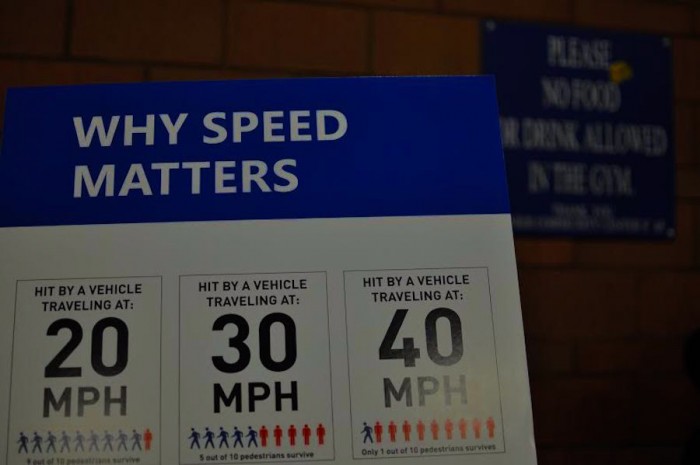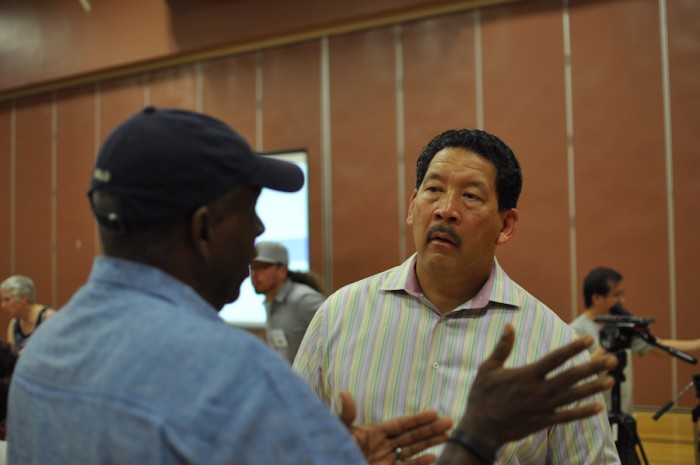
This story originally appeared on the South Seattle Emerald, and has been updated since its original publication.
Near the Columbia City light rail station, three men peer under the raised hood of a red Jeep. The Jeep is parked in a driveway in front of a house, tidy but older.
At the end of the block, a building is under construction.
The men gaze at the unfinished plastic-wrapped shell. The apartments-to-be loom over the men and the Jeep as people rush passed towards the Rainier Beach Community Center. It’s just after 7 p.m. on Thursday night, and a meeting is about to commence — a public information session about three planned traffic safety projects in the South End.
Together the three represent the city’s biggest push into the neighborhood since building the light rail, as part of Mayor Ed Murray’s Vision Zero plan, which aims to bring traffic-related fatalities to zero by 2030. In attendance were Murray, City Councilmember Bruce Harrell and Scott Kubly, the director of Seattle’s Department of Transportation (SDOT), who explained three transportation projects.
Nearly 300 people packed into the community center gymnasium for the presentation. Sitting shoulder-to-shoulder on bleachers beneath basketball hoops and around tables across the court, attendants found no air conditioning to relieve them from the hot and muggy night. Paper plates handed out for a meal beforehand soon found themselves re-purposed as fans. Just minutes into the introduction the sound system broke.
“This is hilarious!” Bruce Harrell shouted.
“No!” shouted back someone in the crowd. “It’s an insult!”
In a way, it didn’t matter, because the story was one every South End resident already knows. Rainier Avenue is bad. This past decade, Rainier Avenue has seen nearly 3,600 collisions, 11 traffic-related deaths and more than 1,700 injuries, according to SDOT. Between January 2011 and September 2014 alone, police reported 1,243 total collisions, 630 injuries and two fatalities along the the busy corridor.
“Almost any place someone could have been hit and injured or killed,” Jim Curtin, SDOT’s community traffic liaison said to the crowd, “someone has been.”
Rainier Avenue is the lifeline of the community, but it’s also a graveyard — a crash-factory that eats dreams — and the plan is to choke it.
Or not to choke it, as Curtin takes pains to point out, but to tighten it. Box it in. Discipline it from an unruly tangle of dangerously intersecting journeys, to an artery shuttling traffic north and south with as few stops and as few obstructions as possible. SDOT wants to apply a “road diet,” a type of transportation construction that involves adjusting street lane widths and/or number of lanes, according to SDOT.
What a road diet plan would do:
- Slow down traffic and eliminate swerving between lanes by removing two travel lanes
- Keep traffic moving with longer signal times
- Get turning drivers out of the way by adding a center turn lane and right turn lanes
- Add separate bike lines and pullouts for buses
There are other components being presented besides the so-called road diet: corridors with slower speeds, improved stop signs and crossings, and smooth sidewalks to make greenways safe for pedestrians and cyclists; spurs off of main corridors connect schools and parks; and traffic calming measures are slated for some streets.
But the subject that was on everyone’s mind, and the one that took most of the presenters’ time, is the road diet, with its counter-intuitive — but nationally proven — promise to speed up traffic by removing a lane.
(See a complete list of the projects covered at the meeting).
After the presentation, six-year South Seattle resident Porsha Stone sat on the bleachers with a popsicle handed out by city staff, and captured the range of mood at the event.
“I like that they had data behind it,” Stone said. “It’s evidence-based.”
Then she added, “what they’re saying sounds great, but I’ll believe it when I see it.”

Many in the crowd voiced similar concerns, and a few loud complaints, including that a focus on traffic was misguided when gunfire has become so common in the area. But beyond from the plan itself, residents seemed skeptical of the city’s willingness and ability to follow through on its promises.
Standing outside the gym, South Seattle resident Patricia Paschal put a finger on it. The city looks like it’s doing its homework, and listening to residents’ concerns, she said. But, she added, none of it will be any good if the new plan is no better enforced than the old one.
Looming over the meeting, too, was a larger question: will the people who’ve lived in the Rainier Valley all along be able to keep living here long enough to enjoy the benefits of safer streets?
“The loudest voices are the ones that were last in the neighborhood. It’s definitely gentrification,” said Sebrena Burr, an area resident since 1975, who attended with her mother, Mary.
If not carefully thought out, Burr added, the project’s increased enforcement could also bring increased racial profiling – an irony in one of the city’s blackest neighborhoods.
“I think the project is a help to move us out further south.”
During his talk, Curtin said the number of crashes and deaths on Rainier Avenue in the last 10 years had made the department open its eyes.
Asked afterward why, if the numbers had been bad all along, it took his department 10 years to open its eyes, SDOT director Scott Kubly spoke frankly.
“I can’t speak to the past,” he said. “I can say we know we have a record number of crashes, and we’re going to go in and make some changes.”
The meeting let out late. Down the road, a burrito truck is closed up. Nearby, one of the city’s new automated bus signs showed the wait for the No. 7. Sitting at the bus stop, a man is cursing softly into his cell phone, only the tiniest bit of iron in his voice. Over and over again, he calls the listener on the other end a liar.
In glowing letters, “La Luz del Mundo” is spelled out on the front of a church across the street. A tent is set up in its parking lot, with lights and tables. Inside, men in suits and women in dresses sit, or stand and embrace, including one man in a tuxedo and a woman in a long white gown. Two teenagers chase a third out and down the sidewalk, trailed by a child. The two grab the third, bear hugging him, trying to get at something he holds behind his back.
“Stop, stop,” one says to him. “Give it back.”
As if on cue, all three run back inside.
An older Asian man walks up to the stop, a pop song playing from his pocket. He doesn’t wait for the bus but dances, bopping and shuffling, now and then lifting one knee high, then the other, all the time humming along to the music.
Even as the community is poised to change around it, life on the busy corridor goes on.
This story has been updated since its original publication.

